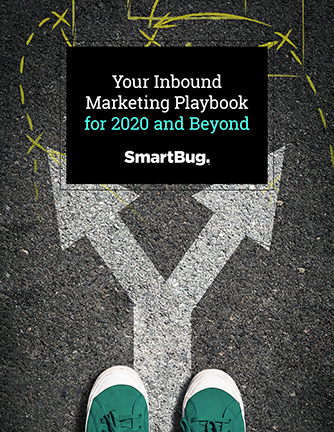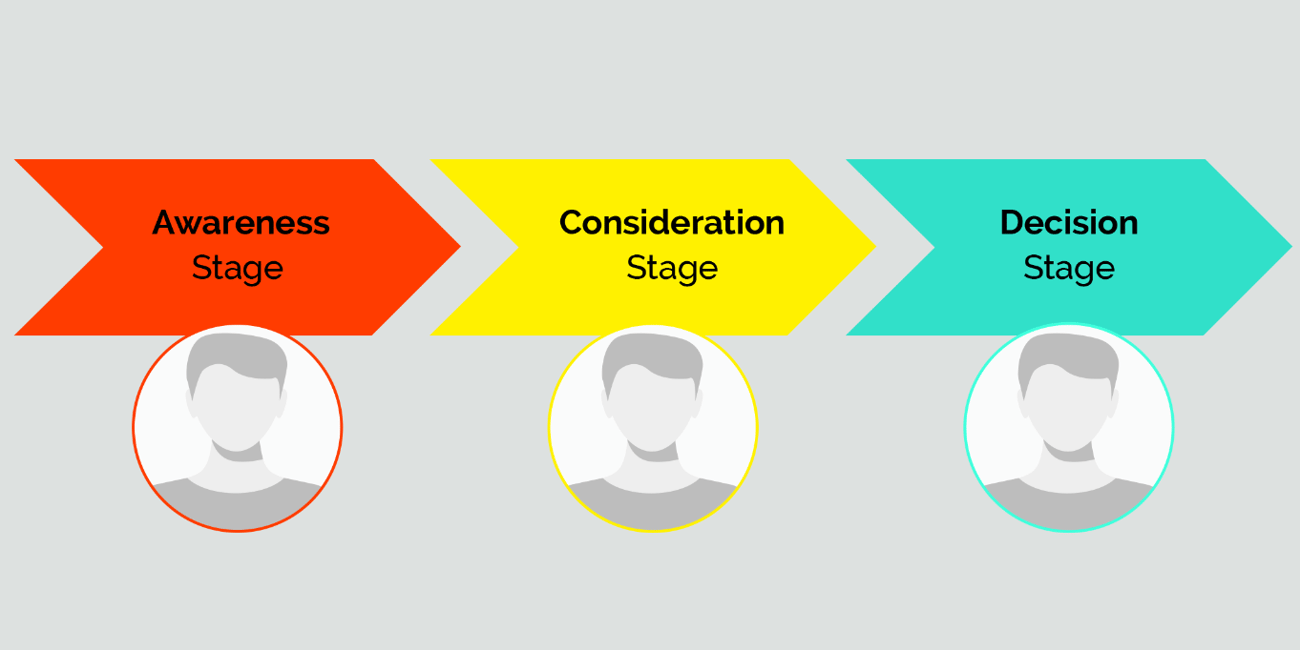
Your Inbound Marketing Playbook for 2020 and Beyond
Helping Marketers Across Industries Survive and Thrive During a Crisis
In this guide, we explore why businesses should keep marketing during difficult times, how businesses across industries can focus on meeting customers where they are no matter the budget, and ways to nurture customer relationships for the long haul—all with inbound marketing.
Download a PDF version of this guide by filling out this form, or keep scrolling to learn more.

Chapters
The Business Case for Marketing in a Crisis
The Origins of Inbound Marketing
How Inbound Marketing Works—Even in a Crisis
5 Marketing Challenges and Inbound Solutions
Inbound Marketing for SaaS During a Crisis
Inbound Marketing for Finance During a Crisis
Marketing for the Manufacturing Industry During a Crisis
Marketing for Senior Care During a Crisis
Planning for What Comes Next
- The Business Case for Marketing in a Crisis
- The Origins of Inbound Marketing
- How Inbound Marketing Works—Even in a Crisis
- 5 Marketing Challenges and Inbound Solutions
- Inbound Marketing for SaaS During a Crisis
- Inbound Marketing for Finance During a Crisis
- Marketing for the Manufacturing Industry During a Crisis
- Marketing for Senior Care During a Crisis
- Planning for What Comes Next
- Download
The Business Case for Marketing in a Crisis

The key to surviving and thriving during times of crisis is to never stop marketing and advertising. In this chapter, we dig into historical economic downturns and how going dark isn’t the answer for cutting costs or staying top of mind in a crisis.
During economic downturns, businesses tend to do whatever it takes to achieve short-term security, which often means cutting jobs and marketing budgets. But companies that cut costs faster than their rivals don’t always come out on the other side as the winner.
In 2010, Harvard Business Review (HBR) took a look at the 1980 crisis, the 1990 slowdown, and the 2000 financial bust, studying nearly 5,000 public companies to understand how they fared before, during, and after these economic crises. HBR found that just 9 percent of businesses flourished, while 17 percent didn’t survive at all. Of the businesses that survived the economic downturn, roughly 80 percent were still struggling to regain pre-recession growth rates three years after the fact.
HBR found that businesses who cut costs aggressively had the lowest probability of pulling ahead of the competition, and businesses that invested more during difficult economic times had a 26 percent chance of becoming an industry leader once the new normal arrived.
According to HBR’s findings, the businesses that are most successful during and after times of crisis take the following approach:
- They improve operational efficiencies to cut costs.
- They take advantage of decreased costs in order to purchase property, machinery, and other physical assets.
- They create new opportunities by making significantly greater investments than their rivals do in R&D and marketing.
Additionally, the most successful businesses aren’t the ones slashing employee numbers. In fact, companies that lean solely on employee layoffs to cut costs only have an 11 percent probability of succeeding after a downturn, largely because layoffs kill company morale and make scaling quickly post-crisis difficult.
Consider legendary Walmart founder Sam Walton who was asked in 1999 about how he weathered the 1990 recession. His response: “I thought about it and decided not to take part.”
This has been the approach of some of the most well-known brands in the world, including Amazon, Kellogg’s, Pizza Hut, Taco Bell, and Toyota. All of these companies made the bold move of increasing marketing and advertising budgets during historic recessions and reaped the benefits. Also on that list is Target. During the 2000 recession, Target reduced its operating costs and narrowed its distribution margins, all while increasing its marketing and sales budget by 20 percent. Not only did Target rise from the ashes of a recession practically unscathed, but it continues to reap the benefits of a bold approach to marketing during a crisis with online sales today up 275 percent year over year.
No matter what’s happening in the world, marketers must continue to adapt and meet changing market demands and consumer needs. A marketer’s job during times of crisis must be to support customers while being honest about what your business can and cannot provide. Avoid taking actions that may offer short-term business stability at the expense of customer trust. Instead, adapt and focus on long-term, data-driven inbound marketing strategies that put the customer first.
A marketer’s job during times of crisis must be to support customers while being honest about what your business can and cannot provide.
The Origins of Inbound Marketing

Long before the inbound methodology arrived, marketing and advertising relied on costly and ineffective outbound strategies. In this chapter, you’ll learn how inbound marketing evolved and solved many of the challenges of traditional marketing strategies.
Inbound marketing is much older than you probably think it is, finding its roots in the 19th century! In the mid-1850s, Cyrus Hall McCormick took a radical approach to marketing his then-radical farming invention—the mechanical harvester—when he developed new methods for generating consumer interest by leveraging market research. Several decades later, Richard W. Sears and Alvah Roebuck acted similarly when they published a catalog that allowed them to easily capture customer information in exchange for a catalog.
In the 1950s and ’60s, market research tightened its grip and set off a wave of interruptive outbound marketing in the form of billboards, door-to-door sales, TV and radio commercials, print ads, and cold calling. Luckily, by the 1970s, Peter Drucker—considered the patriarch of modern business and marketing—was gaining traction with his approach to market segmentation and the idea that marketers had to “know and understand the customer so well that the product and service fits him and sells itself.” Drucker believed that with the right marketing strategy, “logistics rather than salesmanship” were what could most successfully and efficiently close a sale.
And then, the internet came along and changed everything marketers thought they knew about consumer habits:
- The first search engine and Amazon.com launched in 1995.
- SEO was coined in 1997.
- PPC advertising took hold in 2000.
- LinkedIn was founded in 2002.
- Facebook arrived in 2004.
- YouTube hit the airwaves in 2005.
- Twitter launched in 2006.
- Instagram went live in 2010.
- Mobile forever changed marketing in the 2010s.
Consumers wanted to be marketed to, not marketed at, which meant marketers needed to create powerful, tailored user experiences that made sense for each individual consumer at each stage of their unique Buyer’s Journey. This is where we arrive at the official birth of “inbound marketing” as a strategy, as well as HubSpot, the brand synonymous with this methodology.
Today—whether operating in a pandemic, recession, or business as usual—inbound marketing uses relevant content that is catered to consumers throughout each stage of their journey in order to guide buyers through the Buyer’s Journey. Through inbound marketing, consumers find brands through search engines, social media, blog articles, paid media, and more.
With the rise of predictive analytics and artificial intelligence, marketers will soon be able to learn more, faster, and deliver an even better, more personalized experience. Think websites with extreme personalization that deliver returning users a completely catered experience. This extreme personalization will inevitably streamline the sales process—and deliver on Drucker’s dictum that by knowing and understanding a customer well enough, the product or service can simply sell itself.

How Inbound Marketing Works—Even in a Crisis

In this chapter, we explore the pillars of inbound marketing—including buyer personas and the Buyer’s Journey—and how this strategy can help businesses across industries survive and thrive during challenging times.
Inbound marketing is a strategy that meets customers where they are by providing personalized content and experiences—in stark contrast to outbound marketing, which relies on an impersonal blitz approach to reaching customers using TV and radio ads, cold calls and emails, and direct mail.
Some of the inbound methods marketers know and love include:
- Blog articles
- Infographics
- Case studies
- White papers
- E-books and pillar pages
- Webinars
- Social media posts
- Podcasts
Inbound marketing is a customer-first approach that helps buyers better understand their problems, guides them through possible solutions, and hopefully secures their business. But before you launch an inbound marketing campaign, you must understand your buyer personas and the stages of the Buyer’s Journey.
Buyer Personas
Buyer personas are the semi-fictional representations of your ideal customers based on real research on real customers. Your buyer persona research uncovers your customers’ pain points and challenges, how they get their information, demographic details, and more.
Why is it crucial to have buyer personas fleshed out when developing your inbound marketing strategy? The better you understand your buyer personas, the better you’ll be able to reach, nurture, and eventually convert leads with the right content at the right time.

The Buyer’s Journey
Customers don’t want to be sold to or talked at, which is why traditional outbound methods don’t resonate with buyers. Even more so during times of crisis—when customers are watching their bottom lines and planning carefully for the future—prospects want to know that they’re being heard and that businesses are respecting their decision-making processes.
Now more than ever, inbound marketing is effective because it understands buyer pain points and challenges, how they research solutions, and how they make decisions. Inbound marketing meets prospects wherever they are by creating content for every stage of the Buyer’s Journey in order to nurture leads through the buying process.
Here are the three stages of the inbound marketing Buyer’s Journey:

Awareness
At this stage, prospects realize that they have a problem. Content at this stage should be informative, answer simple questions, and solve basic problems without any self-promotion. Think explanatory, 101-style blog articles, e-books, and infographics that use “how to” or “ultimate guide to” in the title and establish your brand as an expert and thought leader.
Consideration
At this stage, prospects have decided to find a solution for their problem and are weighing their options. Content at this stage should help the reader by explaining the solutions available on the market. Think checklists, calculators, case studies, vendor comparisons, white papers, reports, and webinars.
Decision
At this stage, prospects are ready to become a customer—they just need a final nudge to sign on the dotted line. Content at this stage takes a more direct, sales-driven approach, with offers such as product spec sheets, competitor comparisons, case studies, fact sheets, and product implementation guides.
Why Inbound Marketing Works During a Crisis
Inbound marketing is a long-term investment focused on long-term growth—punctuated with quick wins when and where they count—which means kicking off an inbound strategy now can guide you through these difficult times and launch your business into the new normal.
An intelligent approach to inbound marketing lets you think beyond pandemics and recessions with evergreen strategies like content creation, social media, paid advertising, and lead nurturing. You may have the time now to repurpose the content you already have and achieve some quick wins, but you also must create long-term strategies and build the processes and practices now that will serve you today, tomorrow, and throughout the future.
If you believe that your product or service solves real problems for real people, economic and societal fluctuations won’t change that reality—so keep marketing and never go dark.
You must create long-term strategies and build the processes and practices now that will serve you today, tomorrow, and throughout the future.
5 Marketing Challenges and Inbound Solutions

Although the impact of a recessionary and pandemic-driven economy varies from industry to industry, the marketing challenges tend to be similar. In this chapter, we’ll address five common challenges businesses across industries are facing right now and how you can overcome them with inbound marketing.
Challenge #1: How do we evaluate performance metrics right now?
Most marketers will be looking at their marketing and sales dashboards this year and wondering if the dips or peaks are tied to the pandemic or the recession—or whether it’s just business as usual and something else is going on.
Although it’s not a bad idea to have an eye on metrics, it’s equally important to be realistic, which may involve resetting your sales and marketing expectations, KPIs, and goals. Depending on the nature of your business and industry, you may need to drastically shift the types of metrics you rely on to measure success during this period.
Here are some examples of short-term tactics that will help in the long term:
Find the industry baseline.
Look at industry-wide trends and metrics to get a full picture of how your data measures up. Also, watch what your competitors are doing online during this period—whether they’re posting updates to LinkedIn’s 90 million senior-level influencers or sending email marketing updates on product and service offerings. Understanding what the industry landscape looks like and what the benchmarks are will give you a more realistic picture of how you’re performing in the scheme of things.
Focus on what’s free.
If you have a free trial or subscription offering, now is the time to put it to work. Create lead nurturing campaigns for contacts who have downloaded and are using your product or service so that when the economy stabilizes—or they realize they simply can’t live without you—they’ll become customers. Watch engagement metrics on your lead nurturing campaigns, see how people are talking about your product or service on social media, and measure how users are engaging.
Focus on client retention.
It can cost 6-7 times more for a business to attract a new customer than to retain an existing one. If attracting and engaging new leads isn’t in the budget right now, then turn your attention to delighting your current customers. which means exceeding their expectations in order to build loyalty and avoid churn. As you delight your customers, keep an eye on engagement metrics and churn rates, as well as data around upselling, cross-selling, and referrals.
Look at the right numbers.
Instead of focusing on page traffic, for example, look at conversion rates for a more accurate picture of what your buyers are doing. Let’s say you have a landing page whose traffic dropped dramatically in early 2020; it’s still converting at 20 percent, but has converted fewer contacts than you anticipated. If your conversion rates are still hitting the right marks, then your traffic numbers aren’t going to be as vital for reporting.
Challenge #2: How can we market without looking opportunistic? What if there’s no demand right now?
Although most businesses are afraid of coming off as insensitive, opportunistic, or even tone-deaf while marketing and selling during challenging economic times, the world is still spinning and people are still buying. In fact, businesses that take a bold, confident approach to marketing have the opportunity to gain customer trust and share of voice when so many other companies are curtailing marketing efforts.
Consumers want to hear from you, they just want to be able to trust that you have their best interests in mind. The key is to not add to the noise but to break through it with meaningful content and intentional, thoughtful messaging that hits the right notes—which requires knowing your audience.
Consider the creative paid advertising that arose during COVID-19 from brands including Coca-Cola, Volkswagen, and Mercedes-Benz, which modified their logos on social posts to encourage social distancing and safe, healthy practices. Similarly creative was Israeli candy bar Keef-Kef, which changed its logo and packaging because, in Hebrew, keef means “high-five” and kef means “fun,” and that high-five just wouldn’t fly during a pandemic—but fun always does.
Shift toward brand messaging and being helpful, and move away from performance- and sales-oriented advertising. By practicing social listening, you can develop empathy for the state of mind of your customers, which can help you perfect the art of building brand awareness through blog articles, helpful and educational videos, live Q&As, and more.
Focus on helping your buyers understand and explore their problem so that, when the time is right, they’re ready to become a customer. Additionally, remember that it is always cheaper to retain and upsell your existing customers, so create content and leverage strategies to delight your current customers.
![]() Pro Tip: According to data from Adobe’s Digital Economy Index, U.S. e-commerce sales were up 49 percent in April 2020. Additionally, McKinsey & Company has found that American consumers intend to increase their online shopping in the near future. If you’re a brick-and-mortar that hasn’t tried selling online or a company that has always relied on on-site sales, now is the time to stretch your e-commerce legs and meet your customers where they are.
Pro Tip: According to data from Adobe’s Digital Economy Index, U.S. e-commerce sales were up 49 percent in April 2020. Additionally, McKinsey & Company has found that American consumers intend to increase their online shopping in the near future. If you’re a brick-and-mortar that hasn’t tried selling online or a company that has always relied on on-site sales, now is the time to stretch your e-commerce legs and meet your customers where they are.
Challenge #3: What can marketing do if our budget has been cut and we’ve been told no paid, no social, no email marketing beyond company updates?
During difficult and uncertain economic times, businesses across industries have a tendency to hunker down and cut budgets to protect short-term profitability. With marketing viewed as a cost center at most businesses, it’s important to reframe the conversation and remember that marketing is an investment. Try to remove “marketing budget” and “marketing spend” from your vocabulary and hopefully, doing this will change the conversation with the C-suite. Focus on influenced revenue to arm your marketing team with internal justification for marketing ROI.
But if you’ve been given strict guidance about where not to spend your time and money, there are plenty of marketing efforts you can cross off your internal to-do list while you wait for a more stable environment to pitch your dream campaigns. People are spending more time than ever online—web traffic was up in March over February—which makes now the perfect time to make sure you’re controlling your brand narrative across every corner of the web.
Here’s a list of some internal tasks you can tackle while you wait out the storm:
- Clean up your contact database, analyze cold leads, and set up email marketing workflows.
- Review and update your buyer profile and buyer personas.
- Audit your website and tackle 404 errors, meta descriptions, alt tags, duplicate content, and so on.
- Tackle SEO optimization across your website and blog.
- Audit your existing blog content in order to build a high-performance pillar page or e-book.
- Update your social media channel images, descriptions, and links—then encourage your employees to do the same.
- Check your local listings and update accordingly.
- Test your website for accessibility compliance and update accordingly.
- Try new productivity or project management tools to refine your processes.
- Spice up your 404 pages to stand out.
- Create a library of evergreen social posts.
- Interview internal subject matter experts (SMEs) for future content or record webinars for future release.
But wait, there’s more! Marketing can stay busy by working more closely with sales—even if sales efforts have slowed down. Take this time to sync with sales in order to build out a library of sales enablement content that addresses buyer pain points and challenges. There is no better source to learn about the common objections your buyers have—regardless of recessions and COVID-19—than by speaking with sales, so focus on nurturing marketing’s relationship with sales in order to achieve better alignment.
You can also spend more time getting to know your current customer base by asking questions such as:
- What are some challenges customers are still having?
- How do they feel about your current products and services?
- How can you help them during these difficult times?
- What kind of features would they like to see?
If you have time on your hands, chances are your buyers do too. Be sure to thank them for their time and provide incentives if and when you can.
Challenge #4: We want to stay top of mind, but what can we offer our prospective buyers?
First and foremost, focus on growing your share of voice through education, not promotion. Now is the perfect time to create content with high-value keywords or to create large or complex premium content pieces for future deployment and promotion.
Although 90 percent of marketers are reviewing marketing budgets because of COVID-19, the only things about your strategy that need to change are your messaging and where you focus your time and energy. (Historically speaking, cutting marketing budgets during times of economic crisis has been a failure for some of the world’s largest brands.)
Cutting marketing budgets during times of economic crisis has been a failure for some of the world’s largest brands
Share of voice represents how much of the conversation your brand owns in comparison to your competitors. The greater your share of voice—through paid advertising, social media, SEO, and more—the more authority and greater name recognition you have with prospects. As your competitors inevitably cut back on advertising and marketing because of concerns about being tone-deaf or because marketing is often the first department to see cuts during economic downturns, it’s important for you to keep marketing and growing your share of voice.
Here are some ideas for staying top of mind while being respectful of the current economic climate:
- Continue creating buyer persona-driven content, whether that means optimizing and updating old posts, transforming topical content into a pillar page, or writing new blog articles.
- Offer proofs of concept or 30-day trials to get prospects in the door without any pressure.
- Start hosting live webinars or Q&As, and share them on demand on your website or social channels for those who may have missed them.
- Create a dialogue between customers and prospects by leveraging user-generated content and social proof on your social media channels or blog—just be thoughtful about what content you curate.
Going dark is never a way to display transparency and understanding of the current situation, so don’t shy away from social media during times of crisis. In fact, although eMarketer had originally predicted just a six-second increase in social media consumption in 2020, the market research company is now predicting a nearly seven-minute increase from 2019—the first positive growth since 2017. That means Americans will spend an average of one hour and 22 minutes per day on social channels, with Instagram seeing the greatest increase at 13.8 percent.
Going dark is never a way to display transparency and understanding of the current situation, so don’t shy away from social media during times of crisis.
Challenge #5: What if we start something new but can’t keep it up when things get back to normal?
Right now, planning ahead probably feels challenging—if not absolutely impossible—but now is the time to try out new strategies and leverage resources. Being bold can’t hurt and it can diversify your offerings while building brand awareness. If you’re eager to explore new opportunities but are worried about keeping up once the new normal sets in, consider partnering with an inbound agency to help you keep things chugging along while you return to mission-critical tasks.
Let’s take a look at some inbound marketing tactics you can implement for your specific industry as you strive to thrive and overcome times of crisis.
Inbound Marketing for SaaS During a Crisis

Although Gartner predicted that the global SaaS market would swell to $116 billion in 2020, worldwide IT spending is now predicted to decline by 8 percent in 2020. In this chapter, you’ll learn how inbound marketing strategies can help SaaS businesses overcome economic uncertainty and provide long-term value to prospects.
With cloud pricing models and no long-term commitments, marketers know that the SaaS industry is susceptible to disruption. Although many SaaS providers—including those in the edtech, fintech, and telemedicine verticals—are experiencing major subscription gains right now, others are struggling to retain current customers. In fact, many companies are taking advantage of the economic downturn in order to cancel subscriptions or negotiate more flexible SaaS terms.
Now is the time to level up your marketing game if your SaaS solution:
- Can help companies transition their workers to a more effective and productive remote environment
- Makes it easier for online transactions and digital transactions
- Is low code or no code
According to a Gartner survey, 74 percent of CFOs plan on moving at least 5 percent of previously on-site workers to permanently remote positions following COVID-19.
Many companies are taking advantage of the economic downturn in order to cancel subscriptions or negotiate more flexible SaaS terms.
SaaS collaboration tools, including Slack, Zoom, and Microsoft Teams, have seen explosive growth, and companies will continue investing in digital transformation tools to facilitate the new normal. According to Gartner, businesses are planning to spend more throughout 2020 and beyond on cloud-based telephony/messaging (8.9 percent) and cloud-based conferencing solutions (24.3 percent).
If you’re a B2B SaaS company that offers solutions for healthcare providers to deliver virtual consultations or services, you’re also in a great position for explosive growth. In its report on consumer sentiment, McKinsey & Company found increased usage of telemedicine for physical and mental health, with more than 50 percent of the increased usage representing new users. Additionally, Forrester now predicts that virtual care visits will soar to more than 1 billion in 2020 with 900 million of those visits related to COVID-19.
No matter what type of SaaS solution you offer, here are the inbound marketing strategies we recommend for SaaS organizations throughout 2020 and beyond:
- Ramp up promotion for free trials like Google did with its Zoom rival, Meet.
- Consider discounting short-term subscriptions. (Check out our list of free and discounted tools here.)
- Ungate features on free subscriptions, like Zoom did with its meeting room limits for K-12 organizations.
- Leverage paid media to boost brand awareness.
- Focus on retention and delighting current customers.
- Create blog and premium content for every stage of the Buyer’s Journey.
- Step up your SEO strategy with a site audit, tackling pesky projects.
- Accelerate the release of new features or upgrades for paid subscribers to encourage retention.
- Maximize lead generation by ramping up reviews on third-party sites.
If you’re creating content, posting on social channels, or using paid media, the key is to use the right messaging so you don’t seem opportunistic or tone-deaf. We like what Skuid has done on this page by focusing on the challenges of working from home while offering support and guidance. Skuid weaves in messaging about how its custom Salesforce apps can make life easier, but the tone of the page is first and foremost empathetic and understanding—not promotional.
Additionally, check in with your development team about innovation initiatives and start talking about those initiatives on your blog, social media, and in your email marketing campaigns. During economic downturns and times of crisis, consumers expect businesses to slow down—but challenging times are the perfect opportunity for SaaS companies to speed up and innovate to solve problems with groundbreaking solutions.
Learn More About Inbound Marketing for SaaS
The Savvy SaaS Marketer’s Quick Guide to Paid Marketing
Read More5 SaaS Marketing Strategies to Implement in the Face of COVID-19
Read MoreThe 6 Most Effective Paid Marketing Channels for SaaS Companies in 2020
Read MoreSaaS Marketing Strategies: Getting Quick Wins and Building for Long-Term Victory
Read MoreInbound Marketing for Finance During a Crisis

The finance industry has been focused on technological transformation for years, and crisis situations often magnify and accelerate the need for change. In this chapter, you’ll learn how finance businesses can leverage inbound marketing strategies to stay relevant even during economic uncertainty.
According to research by McKinsey & Company, the majority of consumers worldwide expect the financial effects of COVID-19 to be long-lasting. Although banking services are necessary for everyday life, the way banks communicate during challenging times must change. Immense effort must be put into developing customer-driven messaging and marketing strategies with the goal of building trust and putting consumers at ease.
“The first thing banks and credit unions need to do is reach out and touch consumers in a way that shows that they genuinely care. Whenever there’s uncertainty, people are always looking for some advice … they’re looking for some help,” said Rohit Mahna, SVP of Financial Services at Salesforce. “Customers are looking for a constant level of engagement, constant level of updates, and education on what they should do.”
Now more than ever, banks and credit unions must deliver exactly what customers need, when they need it. If your development teams are modifying products to help eliminate stress and anxiety, such as by increasing online transfer limits, be sure to let your customers know. Additionally, ask your customers what services they would like to see from your bank or credit union, and find a way to deliver new and innovative options beyond mobile banking alone. Above all, be direct, honest, understanding, and focus on a customer-first approach to marketing.
Here are some additional inbound marketing strategies to implement now and going forward:
- Build landing pages based on each of your buyer personas and their most pressing pain points and challenges (e.g., stimulus checks, business relief).
- Place a callout—banner, overlay, or popup banner—on your homepage that explains how your business is operating during the crisis (e.g., opening hours, measures to protect employee and customer safety, and so on).
- Communicate continuously with customers and employees through one-to-one email marketing and lead nurturing campaigns.
- Implement strategic calls to action in your email signatures, on blog content, and throughout your website.
- Send out customer surveys in order to gain insight on what your customers want and need right now.
- Create blog content on current topics (such as what to do with their stimulus check or how to apply for business relief) as well as content with a long-term view (how to build an emergency fund, retirement implications, mortgage refinance options, and so on).
- Be proactive and available across social media, your website, email, and more so that your customers can reach you when and how they need to.
Lastly, remember that your employees also need your support during uncertain times like these. Communicate with your workforce frequently and give them resources to deliver the best customer experience possible—from designated landing pages to email communications to FAQs to targeted blog articles they can share with their customers.
Learn More About Inbound Marketing for Finance
Marketing for the Manufacturing Industry During a Crisis
.jpg?width=1920&height=1124&name=Hero-Chap-7%20(1).jpg)
In this chapter, you’ll learn about how inbound marketing strategies—from pricing calculators to product pillar pages—can help your business survive and thrive amid the evolving manufacturing landscape.
Whether you’re an OEM, distributor, or manufacturer, you’re likely being heavily impacted by COVID-19 and the pandemic-fueled recession, and it’s possible you’re seeing gains from the crisis. According to a Thomas Industrial survey on the impact of coronavirus on the manufacturing sector, more than half of those surveyed are “likely to extremely likely” to bring production and sourcing back to North America—and 47 percent of U.S. manufacturers report that they are now seeking domestic sources of supply.
47% of U.S. manufacturers report that they are now seeking domestic sources of supply.
With so many businesses in the sector reconsidering how they operate, now is the perfect time to focus on creating content for every stage of the Buyer’s Journey in order to generate leads and nurture prospects through the buying journey.
Here are some manufacturing content ideas to try out:
- Product pillar pages
- Pricing calculators
- Spec sheets
- Product FAQs or spec sheets
- Product comparisons
Some additional inbound marketing strategies to implement now include:
- Leveraging video: Share factory tour videos or videos that showcase your company products, services, or employees. Video is a great way to explain difficult concepts or how a product works.
- Updating online catalogs: If you sell complex industrial parts, make sure your online catalogs are up to date with real-time functionality. Many manufacturers don’t have interactive online catalogs, so you can step ahead of the competition and use catalogs as a lead generation tool.
- Setting up a chatbot: Over the past few months, HubSpot has seen a rise in chatbot use, which will only continue to grow. Chatbots are a great way to answer customer questions quickly and automate lead qualification.
- Creating sales enablement content: Connect with your sales teams to find out buyer pain points and challenges and collaborate on sales enablement content that can help convert more leads into customers when the time is right.
Focus marketing efforts on your existing customers by aligning your messaging with their concerns—ask them what they need and how you can help them. Your marketing strategy must be focused on retaining your current customers in order to build brand loyalty and be able to ask for referrals when the time is right.
Learn More About Inbound Marketing for Manufacturing
Marketing for Senior Care During a Crisis

Senior living communities have been hit hard by COVID-19—and may get hit harder by the recession—and marketers are focused almost solely on damage control, not marketing. In this chapter, you’ll learn about inbound marketing tactics that can help senior care providers stay responsive and relevant during a crisis.
Throughout historic economic downturns, senior housing providers that offer assisted living and memory care services (which are considered needs-based services) have fared better than businesses in many other industries. However, prior to COVID-19, senior housing construction had already slowed and combined independent living and assisted living occupancy rates were at their lowest level since Q2 2011. For older adults who were considering moving to a senior living community, COVID-19 and economic uncertainty may have put these plans on hold.
In order for senior care providers to survive and thrive during these unpredictable times, marketers must turn away from promotion and occupancy rates and toward trust, transparency, and education. Inbound marketing is all about helping people solve their problems the way they need to and when they need to do so by offering content that speaks to the challenges they’re facing.
Many senior care and housing providers have relied on a "boots on the ground" approach to driving referrals. However, with in-person tours canceled for the foreseeable future and events no longer an option because of health and safety concerns, senior care marketers must pivot.
Here are some ways that you can use inbound marketing strategies to survive the current reality and prepare for a post-COVID-19 market:
- Acknowledge the current situation and what your business is doing to combat the fear and uncertainty that seniors and their families may be experiencing. Also, be open and transparent about future plans and where more information can be found.
- Create content for every stage of the Buyer’s Journey in order to educate your prospects and speak to their challenges and anxieties.
- Leverage video and virtual tours to cater to those who are still uncertain about visiting even after your community has safely reopened.
- Share what your business has done to address COVID-19—and what you will do in future crises—and where they can find more information.
- Audit your website and then address any site errors you uncover. Spend time optimizing your website(s) for local SEO, clean up your forms and contact database, and focus on strategies for enhancing conversion rate optimization (CRO).
- Test out live chat or a chatbot on your site to answer prospect questions quickly and to properly filter and qualify leads for follow-up and lead nurturing.
- Bring offline operations online by using demand generation and account-based marketing (ABM) tactics.
- Connect with residents and their family members on social media by providing updates, helpful guidance, and more. HumanGood, for example, has been posting workout videos on YouTube and Facebook for seniors to do safely while at home.
Although now is not the time to be soliciting testimonials about the care and services received during this challenging period, adult children and seniors alike will be posting about their experiences on social media, review sites, email, and in face-to-face conversations (at a safe distance, of course). It’s important to collect these stories and testimonials so that, when the time is right, you can use them for paid campaigns or in an e-book about the benefits and security of senior community living during a crisis.
After the COVID-19 crisis is over and the economy turns around, people will be ready to move forward quickly, so focus on transparency and building trust through education fueled by empathy and understanding.
Planning for What Comes Next

Economic downturns offer powerful opportunities for businesses across industries to accelerate growth and expand share of voice—much faster than your competitors, who are likely cutting their marketing investments. Now is the best time to step up your marketing by focusing on getting the most out of every dollar invested in marketing and pivoting your marketing efforts to supporting sales, delighting customers and nurturing relationships, shaping a new narrative in the marketplace, and preparing your marketing team for the future.
As you shift from reacting to the crisis to mitigating the effects of the crisis, it may be time to choose a marketing partner who can meet you wherever you are. SmartBug Media® is a fully remote agency, which means that no matter what happens, we’re ready, willing, and able to help your company survive and thrive.
Schedule Your Intelligent Inbound Marketing Consultation
Download Your Inbound Marketing Playbook for 2020 and Beyond!
Simply fill out this form to receive a PDF version of our guide.




